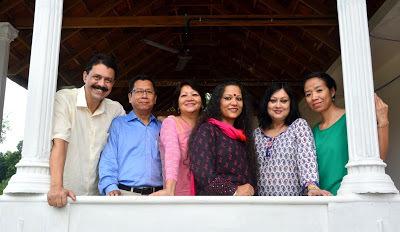One Corner of the Indian Field
 At an international literary festival in Kerala, writers from the North-East talk about their experiences
At an international literary festival in Kerala, writers from the North-East talk about their experiencesPhoto: (From left): Dhruba Hazarika, Robin Ngangom, Streamlet Dkhar , Nitoo Das, Mitra Phukan and Rita Krocha. Photo taken by Ratheesh Sundaram
By Shevlin Sebastian
When Khasi writer Streamlet Dkhar came to know that there would be a photo shoot, she said, “I will come dressed in my traditional costume, the Jainsem Dhara.” And she did. It was in a peach colour. The Jainsem consists of two pieces of material, worn on top of a blouse, with the two ends tied to both shoulders.
The shoot took place at Chengannur, 100 kms from Kochi, where an international literary festival, organised by the South India Writers' Ensemble, took place.
Streamlet has written 17 books, a mix of plays, poetry, fiction and criticism. In her poetry, she has focused on Khasi folk tales. However, in the book, 'Clouds of Emotions', Streamlet focused on a serial bomb blast in Guwahati, well as the terrorist attacks in Mumbai, both of which took place in 2008.
“Most of the poems are about guns, terrorists and innocent victims,” says Streamlet, who is head of the department of Khasi at the North-East Hill University at Shillong.
Asked whether the people are interested in literature, she says, “It was only in the mid-18th century that Khasi got a written script, when we adopted the Roman script brought by Thomas Jones, the Welsh Calvinist Methodist missionary. But our oral tradition is very strong.”
Interestingly, many people in Chengannur asked her about her name. “I was a pre-mature baby, and very small, like a streamlet,” she says. “So that is how my father gave me that name.”
Manipur has diverse communities like the Nagas, Kukis, and the Meiteis. “But the Nagas have differences with the Kukis and the Meiteis,” says Robin, an Associate Professor of Literature at North-East Hill University. “There is a lot of violence.”
Author Mitra Phukan of Assam agrees. “Last year, there were so many killings,” she says. “Our society has become desensitized. Numbers matter now. If only one person is killed it is 'fine'. And that is horrible. The most terrible thing happened during an Independence Day parade of school children at Dhemaji in 2004. There was a bomb blast by ULFA (United Liberation Front of Asom). Many children and mothers were killed. This disturbed everybody in society.”
Mitra, who has written eight books of fiction and non-fiction, is best known for her novel, 'The Collector's Wife'. The background is the student agitation in the 1980s and the beginnings of the insurgency.
Mitra says that despite all the problems, literature is thriving in Assam. “There is poetry, essays and novels which talk about the suffering of the people,” says Mitra. “The thing about good literature is it that it is not judgemental. It speaks of the anguish of the perpetrators as well as the victims.”
In Nagaland, there is not much of an environment for literature. But a few years ago, a beginning was made at the Hornbill festival, at Kisama, which showcases tribal culture. “There is a Hornbill Literature Fest, where writers have found a bit of space,” says Rita.
Meanwhile, at Chengannur, Assamese writers Dhruba Hazarika and Nitoo Das tried to dispel the myth that the North-East is one big mass of collective thinking. “The North-East is a mini India,” says Dhruba. “There are 126 dialects and languages and more than 200 tribes.” Adds Nitoo: “The cuisine, language and culture differ from state to state, and there are excellent writers in so many different languages. It makes the region a fascinating place.”
(Published in the Sunday Magazine, The New Indian Express, South India and Delhi)
Published on August 30, 2015 21:47
No comments have been added yet.



